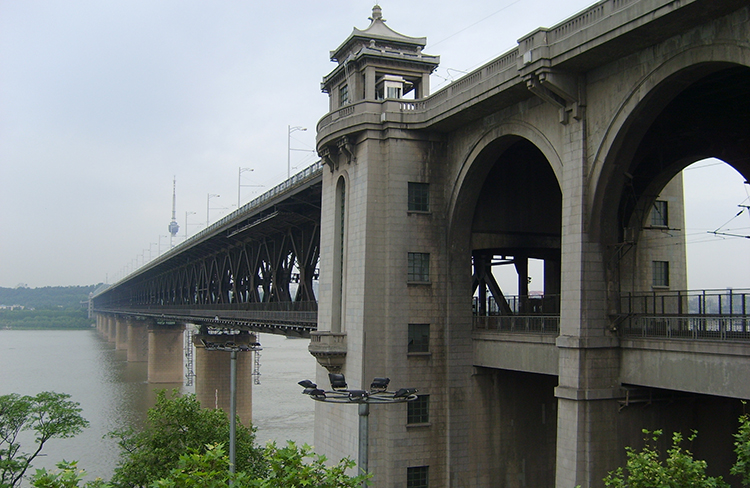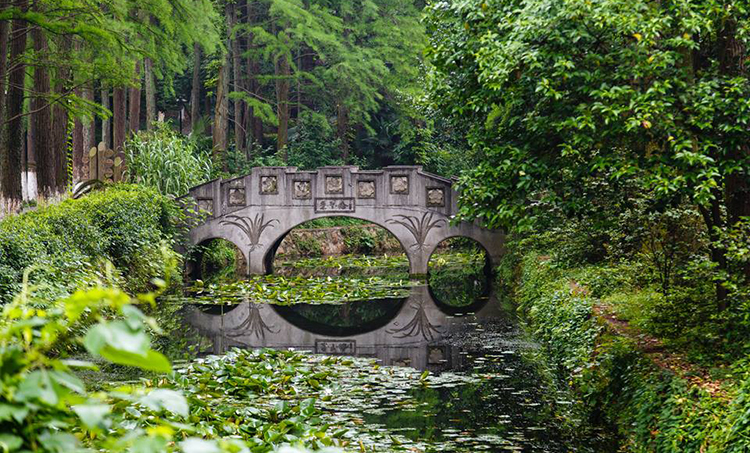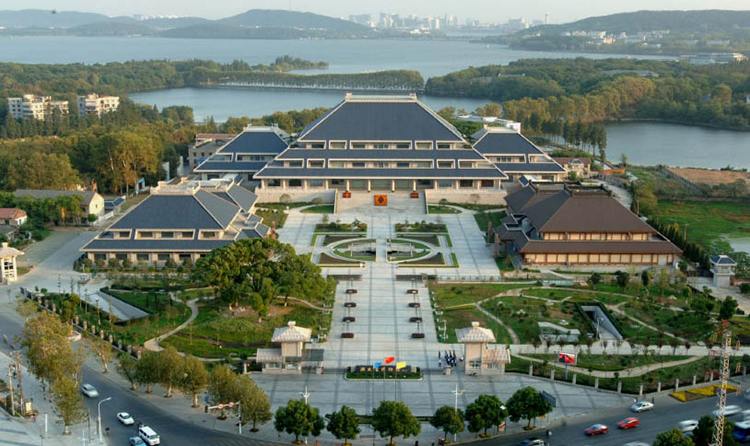Written by: Meizi
Posted on: March 08, 2016 | 
Wuhan City in Hubei, China
As the capital city and the political, economic and cultural center of Hubei province, Wuhan is situated in the middle of China. The Yangtze River, the third largest river in the world, and the Han River, the largest tributary of Yangtze River gather here. The metropolitan area is comprised of three parts - Wuchang, Hankou, and Hanyang, which lie on both sides of Yangtze River, commonly called the ‘Three Towns of Wuhan’.
Wuhan is a typical landscape garden city. There are hundreds of hills spreading all over the three towns, with nearly two hundred lakes inlaid which account for a quarter of the total water area, ranking the first in China's major cities. With a water area of 33 sq. km, the East Lake is the largest urban lake in China. Wuhan is also known as the City of Rivers and the City of Bridges. Both the number of bridges in Wuhan and Wuhan’s bridge industry rank first in China.
In recent archaeological work, it was found that ancient people had already settled in Wuhan more than 10,000 years ago. The historic site of Panlong Town, which is located in the northern suburbs of Wuhan, demonstrates that Wuhan’s city development has a history of 3500 years. In history, Wuhan was the fierce battlefield of the Three Kingdoms (Wei, Shu, and Wu), as well as the place where many major events happened in the past thousand years. The name of Wuchang was coined in the era of Wu when Sun Quan was still alive, meaning ‘prosperous for force.’ Wuchang, together with Hanyang is located at the north of the Yangtze River, and they share the name of Twin Cities. The name of Wuhan has been used since the Ming Dynasty.
As the largest transportation hub in inland China, Wuhan is known as ‘the nine provinces’ leading thoroughfare.’ Since its distances to metropolises in China, such as Beijing, Shanghai, Guangzhou, Chengdu, and Xi’an etc., are all around 1,000 km, Wuhan is the heart of China’s economic geography. Furthermore, Wuhan is one of the four largest railway transportation hubs in China; Port of Wuhan is a major open port and a pivotal one in the Yangtze River basin. Wuhan Tianhe Airport, the largest air harbor in Central China, is the only entry and exit port that can apply landing visas in Central China.
Wuhan has always been the business and financial center along the middle reaches of the Yangtze River. In the late Ming and early Qing Dynasties, Hankou was among those four towns of Chinathat were famous for their prosperous trade. In the early 20th century, Hankou once became China’s second largest foreign trading port and one of the four financial centers. At present, a place of such strategic importance is still swarming with merchants, with the total retail sales of consumer goods breaking through the level of 100 billion yuan. International retail commerce magnates, such as Carrefour from France, Metro from Germany and Wal-Mart from the U.S., have entered into the Wuhan market successively. The Societe Generale from France has established a branch in Wuhan, while more than 10 foreign banks and insurance companies have set up working bodies in Wuhan also.

Wuhan is a vital industrial base in China. The city’s industrial system boasts a relatively complete category and strong supporting capability. With ten leading industries such as steel, automobile, and mechanized equipment etc., a batch of scale enterprises with annual sales revenue of more than 10 billion yuan and a number of famous ‘made in Wuhan’ brands with core technologies are emerging.
As one of the first cities along the Yangtze River allowed to open foreign trade, Wuhan has always been the hot spot and one of the first choices for foreign investment in the Middle West of China. Sixty enterprises of Fortune 500 have invested in Wuhan, while more than 300 other multinational corporations have offices there as well.
Wuhan is one of the important educational and scientific bases in China, with its comprehensive educational and scientific strength ranking the third among China’s major cities. There are 52 colleges and universities in Wuhan, including Wuhan University and Huazhong University of Science and Technology. The number of college students reaches 700,000. Wuhan East Lake Development Zone, where the China Wuhan Optics Valley is located, is the second largest intelligence compact district in China. Its technology development strength leads China in the field of optical communication, bioengineering, laser, microelectronic technique, and new materials etc.
In December 1986, the State Council announced Wuhan as one of the national historic cities. With 26 fixed tourist attractions, Wuhan owns abundant natural and human landscapes. The representative scenery spots include one of the best scenic locations in China – the Yellow Crane Tower, Guqintai where bosom friends meet through landscape of music, and the national beauty spot, the East Lake.
The Yellow Crane Tower was first built in 223 AD during the Three Kingdoms era. Celebrities in all ages, such as Cui Hao, Li Bai, and Bai Juyi, all visited the Yellow Crane Tower and recited poems there. Cui Hao, a poet of the Tang Dynasty, wrote a masterwork which has been spread through the ages: “Long ago a man rode off on a yellow crane, all that remains here is Yellow Crane Tower. Once the yellow crane left it never returned, for one thousand years the clouds wandered without care. The clear river reflects each Hanyang tree, fragrant grasses lushly grow on Parrot Island. At sunset, which direction lies my home town? The mist covered river causes one to feel distressed.” With a height of 50.4 m, the Yellow Crane Tower has five floors and a pavilion roof, while the cornices lie layer upon layer. There are also a pagoda, a tablet corridor, and a mountain gate around the main building, reflecting a unique national style.
Guqintai, alternatively known as Boyatai, is located to the west of Guishan, a hill situated at the north of Hanyang. According to ancient legend, once Yu Boya was playing the qin here, the temperament was recognized by Zhong Ziqi, a man who collected firewood and caught fish for a living. As a result, they became bosom friends. However, Zhong Zi died one day, Yu Boya broke the strings of his qin and vowed never to play it again. Descendants were moved by their deep friendship and the Guqintai was built as a monument. The two musical compositions Gao Shan and Liu Shui, which were played by Yu Boya, have been handed down to the present.
The time-honored Hanzheng Street is one of the oldest streets in Hankou with a history of 500 years. Since the Ming Dynasty, Hanzheng Street had already formed into a town of frequent trades. In the last century, Hanzheng Street had always been the business essence of Wuhan. Tourists who visit Wuhan must go to Hanzheng Street, since it is famous for a diverse range of goods and low prices.

Established in 1953, the Hubei Provincial Museum has a collection of over 140,000 ancient cultural relics, including the world-famous artifact exhibition from the Tomb of Marquis Yi of Zeng and Hubei cultural relic exhibition of ancient music.
The artifact exhibition from the Tomb of Marquis Yi of Zeng contains essential relics of Marquis Yi of Zeng of early Warring States Period excavated in Hubei Sui County (present Suizhou City) in 1978. Over 2,400 years old, the tomb houses more than 10,000 cultural relics. It caused a sensation around the globe owing to the large quantity, diversity types, high value, and good preservation of the relics. The exhibition is divided into eight parts: the sacrifice hall, bronze ware, weaponry, chariots and harnesses, bamboo slip, lacquerware and carpentry, goldware and jadeware, and musical instruments; 360 of the most typical cultural relics are on display. In the exhibition, there are many rare archaeological treasures, such as the sophisticated bronze statue of an antlered crane, the Yi ewer, the ancient weapon, which is still sharp so far, the earliest bamboo slip of China, and the enormous golden cup weighing 2,156 g. The most famous discovery is the set of 65 bronze bianzhong bells, which is capable of playing all kinds of compositions from China and foreign countries, covering a wide range with beautiful timbre. The bianzhong is honoured as a miracle in world music history.
Besides the musical instruments from the Tomb of Marquis Yi of Zeng, the Hubei cultural relic exhibition of ancient music displays 40 ancient music relics of different ages and types discovered and gathered in various regions of Hubei province. In the exhibition, there are yellow and black Taoxiangs, which are original percussion instruments dating back to over 10,000 years ago, i.e. the Neolithic Age; the characteristic Chu colored stone bianpan; the tiger-bird drum; the pitch pipe; and Tang music and dance combination etc., representing the glorious musical and cultural achievement of ancient China.
Other treasured objects that have high historic, scientific, and artistic value are also enshrined here. These include the Sword of Goujian, which is famous for the classical allusion “endure present hardships to revive”; the bronze spear of King Fu Chai of Wu, who was the opponent of Goujian; Chu lacquer painting; Chu legal instruments; bamboo instrument, bamboo slip, the legal instrument bamboo slip of Qing Dynasty, celadon of the Southern Dynasties.

As the saying goes in China: “The top two Kung Fu places in China are Shaolin in the north and Wudang in the south.” The cradle of Wudang Kungfu is Wudang Mountain, which is located in Hubei Province. The founder is Zhang Sanfeng. With numerous sub-sects such as Tai Chi, Hsing, Bagua Palm etc., Wudang Kungfu has excellent value of health maintenance and fitness. While the profound quintessence of Taoism culture is reflected, Wudang Kungfu is a bright pearl of Chinese Kungfu and a national treasure of China. It has a complete theoretical system and technique. With the holistic view of the universe and syncretism between heaven and man as the objectives, following the natural world as the principle, association of activity and inertia and training internally and externally as methods, Wudang Kungfu creates many fist styles and swordsmanship styles with distinguishing features, as well as unique theories and methods.
In late June 1978, after the excavation of the Tomb of Marquis Yi of Zeng, experts suggested the presentation of the ancient bianzhong on stage to promote historical culture. In early 80s, the Red East 1 satellite entered into outer space with the bainzhong-played composition – The East Is Red - and resounded through the universe. In December 1987, the stamp of Marquis Yi of Zeng bianzhong and the voiced stamp holder of small sheet initiated the age of voiced stamp in the world, presenting the appearance and sound of bianzhong to the whole world. After successful replication of bianzhong, Beijing Big Bell Temple invited famous composers, conductors, and performers represented by Peng Xiuwen, a master of national music, to record court music that reflected the impressive and dignified manner of an emperor in former days and traditional world-famous masterpieces with the replica of Marquis Yi of Zeng bianzhong and bianqing. The record was published by China Records Guangzhou Company, to help a wider audience appreciate the sonorous and solemn mien of bianzhong. Besides, Hubei Bianzhong Orchestra carried the replica of Marquis Yi of Zeng bianzhong to perform in Beijing, Hongkong, Taiwan, Singapore, Luxemburg, and Japan several times, and participate in a number of international and domestic major and cultural exchange events with historical significance, such as European cultural city year and celebration of the normalization of Sino-Japanese relations.
In August 1983, the Hubei Music and Dance Troupe reproduced the artistic style, movement, and history of the ancient Hubei people on stage through ‘dance accompanied by bianzhong music,’ which was created by bianzhong material comprising the artistic combination of song, music, drum, and dance. The dance accompanied by bianzhong music earned wide praise and welcome during the visit to the U.S., Canada, Japan Hongkong and other countries. Edward Irving Koch, former New York mayor, said in his thankful statement that the visit of dance accompanied by bianzhong music offered New York citizens a chance to enjoy the fantastic music and dance culture of ancient China and should undoubtedly be an eternal gift that the Chinese people sent to mankind.
You may also like: